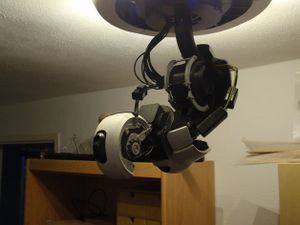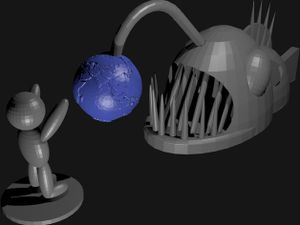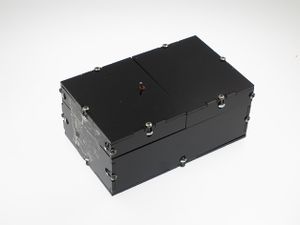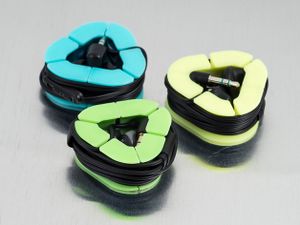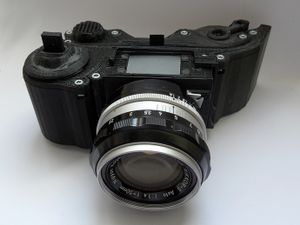User:Tonyarm/Blog
Contents
- 1 Blog 1: Thingiverse Printable Designs
- 2 Blog 2: The Open Source Ecology Kit from Marcin Jakubowski
- 3 Blog 3: Kansas Teen Creates 3D-Printed Prosthetic Hand
- 4 Blog 4: Other's Comments on Blog 2
- 5 Blog 5: How 3D Printing Has Done Over The Years
- 6 Blog 6: The Future
- 7 Blog 7: Using 3D Printed Parts to Replace Expensive Lab Equipment
Blog 1: Thingiverse Printable Designs
Blog Description: "The objective for this blog was to go online to thingiverse.com and look for printable objects in which other people have actually printed. Several particular design criteria we had to look for including: something amazing/beautiful, something funny or strange, something useless, something useful, something which surprised you".
Blog 1a: Something Amazing
In this case, I found a world famous video game character: GlaDOS, also known as the evil machine who loves to test and lies about giving you cake at these tests in Portal. I found this amazing since the guy printed the parts very well. The character is unmistakable. He also added some robotics pieces to make it move and act as a lamp. Check out the clip!
Blog 1b: Something Funny
I just thought this was funny. The picture is self explanatory.
Blog 1c: Something Useless
What is more useless than a useless box?
Blog 1d: Something Useful
I lose my head phones all the time and they get tangled even more frequently. I will be printing these ASAP!
Blog 1e: Something Surprising
I just did not think this was possible, but then again, I have never actually considered it...
Blog 2: The Open Source Ecology Kit from Marcin Jakubowski
Blog 2a: The Ted Talk
Marcin Jakubowski did a ted talk on his ideas on the open source farming equipment. His idea was that industrial grade equipment can be made just as efficiently at a much lower cost. I think it's a very effective idea. Why pay for something much more expensive if you can just build it? In fact, according to the wiki page about him, he has built and constantly uses his tractor, compressed earth brick press, 150 ton hole puncher, heavy duty drill press, and more!
Blog 2b: The New Yorker Article On Him
Emily Eakin of the New Yorker recently wrote an article on Marcin Jakubowskion 12/23/2013 which can be found here. While reading the article, I realized Emily isn't too enthusiastic about the ideas, Marcin, or his enthusiastic visitors. Personally, I think he has a great idea going for him and definitely deserved a much more praise-sounding article.
Blog 2c: Interested Professors
Unfortunately, I do not know of any professors who would be interested in supporting an idea like Marcins's.
Blog 3: Kansas Teen Creates 3D-Printed Prosthetic Hand
On January 31, 2014, an article was posted about a Kansas teenager who printed a 3D-Printed prosthetic hans for the son of a family friend who suffered from a rare condition known as limb difference in which the boys fingers never really grew properly. The teen got the idea, and possibly even the print itself from a site dedicated to creating an open source prosthetic hand design called Robohand. Robohand was started after a man named Richard Van As lost the fingers on his right hand in an accident in May of 2011. He collaborated with a man in South Africa named Ivan and together built the first robotic prosthetic hand made out of aluminum in 2012.
Since the first robotic hand, other people who either lost their fingers or their whole hand have had the privelege of getting some normalcy back with the robotic hands. Such stories include here is a article from The Christian Science Monitor about a father, McCarthy, who 3D-Printed his son a prosthetic hand. The very design came from Ivan Owen and Richard Van As. Another article written by NPR in June 18, 2013 writes about Richard's story and even refernces McCarthy's story.
If I wanted to print a prosthetic hand, I would either look for one on Thingiverse or GrabCAD. If neither option was available, I would probably start from scratch on Solidworks.
Blog 4: Other's Comments on Blog 2
Lee, like, myself, saw the potential for the OSE project to grow and have the possibility to become very useful. Unfortunately, I do not think that it will grow as large as what Lee might think. I really don't beilieve it will get so big that John Deere will try to shut it down.
I think Todd has a reasonable outlook on the growth of the project. As much as we wish that open source projects could run the world effectively, they really can't. It can grow to a point to be reasonably be successful, but still be overshadowed by the larger companies, mainly because of their manufacturing abilities. Even then, they have teams of people who run maintenance.
Chai seems to hold a bit more of a negative view of the project than I do. He makes valuable points of why it wouldn't be totally successful, but I think it can expand much farther than how he described.
Reading Graham's blog reminded me of reading Lee's blog. Both show a large amount of enthusiasm for the project and can see where the projects would be most useful.
Nam's blog seemed to also be very enthusiastic for the project. He did provide a valid point though. The project does have the potential to hurt the income of the larger companies.
I think Jess also has a reasonable view of the project. It definitiely has the potential for something to be successful, but not everyone will have the know-how to be able to do it.
Kevin seems to worry that the open source community will be attempted to be shut down by large corporations. Personally, I'm not sure that enough people have the knowledge or care to affect the large businesses that much in order to make a move. Sure they will face some losses, but I think their main concern is still how well are they doing compared to their corporate competitors.
Dongao was clear that he did not think the project would be that effective overall. However, he did make some valid points. The durability of these products and their safety will be more likely to fall through because the designs will be much simpler. The only way to be truly effective is to make the models as close to the original designs (without breaking patents) as possible, then have upgraded pieces and materials to maximize the efficiency and durability.
Vinny seemed supportive of the project, but realized it's limits in that most people may not have the ability to make such a kit.
Blog 5: How 3D Printing Has Done Over The Years
The Big Step
I think one of the biggest steps in 3D-printing was the first time students were offered to use a 3D printer for their classes. I can honestly say that I have heard nearly every engineering student I have talked to talk about 3D printing something either with a reprap printer or the 3D printer at the learning factory. For a student, having the ability to 3D print something for a project reduces the time it takes to fabricate something, it allows for a better visual for a concept, and it expands the understanding of what and how things can be made. I have personally been part of a project where we made a vacuum using many 3D printed parts such as the diffuser, impeller, separator, and component frames. The vacuum was nearly the best in the class.
Not So Important
Something I saw I really didn't find that important was getting a 3D printed model of your unborn baby. First of all, I think a picture is useful enough on seeing the progression. Second, if there is going to be a 3D model, I would rather not wait for it to be 3D printed and just see it on some CAD program. Third, depending on the progress of the baby's growth, it might look kinda creepy. Overall, I think it would take way too much time and effort to see something when all I would need is a 3D CAD model.
What I Want To Learn More
Something I saw on the timeline that I thought I could get into was the rapid printing of circuit boards. Lately, I have been getting into more mechantronics, mirco-electronics, controls, robotics, etc... Being able to print off circuit boards to make more permanent designs would actually be very useful instead of using temporary wiring boards. Also, some designs, such as my current ME 445 project, have space constraints in which the amount of space can be maximized with 3D printed circuit boards.
Blog 6: The Future
There are a lot of directions to pursue when moving forward. Although, for RepRap users, I think maintenance is in the best direction for everyone. Over the semester, I have come across more problems than I realized were components on these printers. First of all, I plan on starting with monitoring the feed rate of the filament. Too many times our printers would think they are printing, without actually printing. It would be nice to actually have a system that checks to see if the printer is ok. Honestly, for a complex device that runs numerous codes and has numerous independent pieces, it has extremely few checks to make that it is running properly by itself. Sure, half of the class is to make sure that we can make the printers run; however, simple checks should be added to maximize the efficiency of these printers, which in turn will reduce our tempers. But seriously, more of these checks would make our lives a lot easier.
Blog 7: Using 3D Printed Parts to Replace Expensive Lab Equipment
The ability to reduce costs with just as efficient parts is the dream for everyone in the education and research system. Why pay for expensive equipment made mostly of pieces that are great, but unnecessarily expensive, when there are just as sufficient parts that could be printed rather than purchased, possibly fabricated, and shipped? Unless the parts were important, most wouldn't. The Guardian wrote an article on the very subject. They explained how 3D printing lab equipment could allow facilities in poverty effected areas to be able to conduct sufficient research on lower budgets. Personally, I try to go for more lasting products, which tend to be more expensive. However, over my education, I have learned that not all parts and pieces of equipment are required to have a maximum lifespan. Also, some pieces of equipment can become outdated as time goes on. If the parts become outdated, it would be economically efficient for them to recycle the material to create updated parts.
One good example of this online is the story of a PhD student who built an Atomic Force Microscope out of 3D printed parts, LEGO pieces, computer parts and an Arduino Board. The pieces they made and the expensive ones they replaced helped them save almost $100,000. Although, this piece of equipment sounds really hi-tech for something that can be made from simple pieces and 3D printed parts. It almost sounds too good to be true. Looking at the images, I would say the whole thing is not 3D printable. There are definitely parts visibly in there that aren't 3D printed. Also, the fact that
